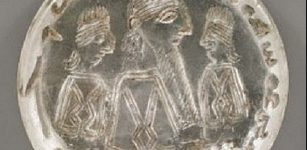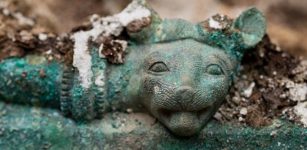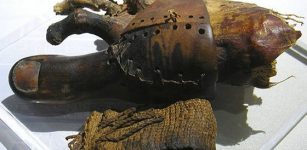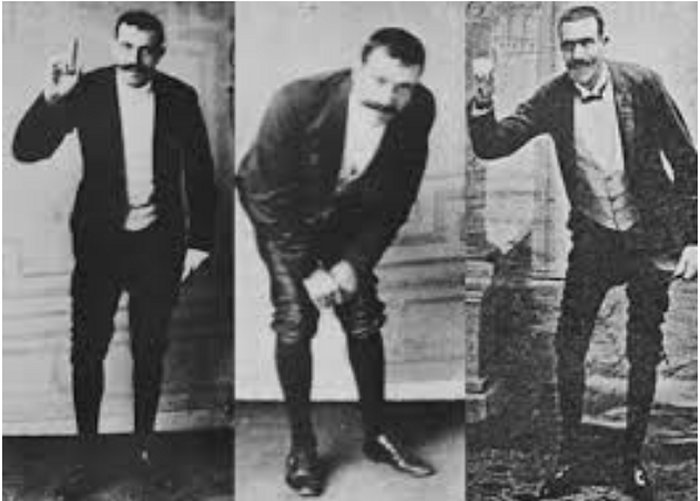Joseph Pujol – The Professional Farter Who Entertained People
Conny Waters – AncientPages.com - History shows no limits in the entertainment world. Since people seem interested in a variety of things, it’s possible to earn money on almost anything, even farting.
Most would think once or twice before farting in the company of family, friends, or strangers, but Joseph Pujol did not let his natural needs and talent be a cause of embarrassment.
Left: Moulin Rouge, Paris, France. Credit: Public Domain - Right: Joseph Pujol. Credit: Public Domain
People loved seeing him on stage, and Pujol became the highest-paid entertainer in 19th-century France. All this sounds strange and unusual. Why would people go and pay just to see someone fart? Actually, it’s not as bad as it sounds, and those who watched him couldn't stop laughing.
Joseph Pujol (1857–1945) who went by the name, Le Petomane, meaning “The Fartiste” had a remarkable ability to abdominal muscles which enabled him to fart at will.
“Pujol didn’t actually pass intestinal gas as part of his stage performance. Instead, he possessed the ability to “inhale” or move air into his rectum and then control the release of that air with his anal sphincter muscles. He discovered his unusual ability as a child when, on a trip to the coast, he realized he could suck water into his anus and project it out with astonishing force. It was said of him that “he could wash your walls with just a bucket and a squat.” As an adult, Pujol was known to create spouts measuring over 16 ft (5 m).
He also found that by varying the force with which he expelled air anally, he could produce different musical notes and while working as a baker, he would entertain customers by imitating musical instruments, claiming to be playing them behind the counter. “ 1
Dressed elegantly in a red cape, black trousers, and white cravat, with a pair of white gloves casually held in his hands, Pujol performed for the first time in Marseille in 1887, and his show was an immediate success. He quickly became famous and traveled to Paris, where he continued to perform at the Moulin Rouge.
The audience was astounded, but there were no doubts he was going to be a huge name in the French capital. People loved his performance and among his audience were famous names such as Edward, Prince of Wales, King Leopold II of the Belgians, and Sigmund Freud.
People loved Joseph Pujol's shows. Credit: Public Domain
“Highlights of his show included the sound effects of cannon fire and thunderstorms, as well as playing “O Sole Mio” and “La Marseillaise” on an ocarina through a rubber tube in his anus. He could also blow out a candle from several yards away. Members of his audience, which included royalty, were known to laugh so hard that some of them passed out.” 1
When people in other countries learned about his shows, they wanted to see him and Pujol embarked on successful tours through Europe and North Africa. Wherever he went, people simply laughed, and his entertainment was very appreciated.
Then, World War I broke out and Pujol left the stage for good. He returned to his hometown Marseilles and continued working in his bakery. Later, he moved together with his wife to Toulon where he started a prosperous biscuit factory.
Joseph Pujol died in 1945, shortly after the Allied had landed. He was buried in the cemetery of La Valette-du-Var, where his grave can still be seen today.
Updated on September 22, 2023
Written by Conny Waters – AncientPages.com Staff Writer
Copyright © AncientPages.com All rights reserved. This material may not be published, broadcast, rewritten or redistributed in whole or part without the express written permission of AncientPages.com
Expand for referencesMore From Ancient Pages
-
 Anundshög Burial Mound: One Of Sweden’s Richest And Largest Sacred Ancient Sites
Featured Stories | Aug 29, 2018
Anundshög Burial Mound: One Of Sweden’s Richest And Largest Sacred Ancient Sites
Featured Stories | Aug 29, 2018 -
 First Leaf Fossils Study Reveals An Ancient 4 Million-Year-Old Forest In Borneo
Fossils | May 3, 2022
First Leaf Fossils Study Reveals An Ancient 4 Million-Year-Old Forest In Borneo
Fossils | May 3, 2022 -
 Ireland, Wales And The Scholar Who Helped Unravel Their Celtic Connections
Featured Stories | Sep 25, 2024
Ireland, Wales And The Scholar Who Helped Unravel Their Celtic Connections
Featured Stories | Sep 25, 2024 -
 Depictions Of Two Biblical Heroines Unearthed In Ancient Synagogue, Huqoq In Galilee, Israel
Archaeology | Aug 24, 2022
Depictions Of Two Biblical Heroines Unearthed In Ancient Synagogue, Huqoq In Galilee, Israel
Archaeology | Aug 24, 2022 -
 Fragarach: Supernatural Sword That Controlled Winds, Cut Through Wood, Metal And Bricks In Irish Myths And Legends
Celtic Mythology | May 14, 2020
Fragarach: Supernatural Sword That Controlled Winds, Cut Through Wood, Metal And Bricks In Irish Myths And Legends
Celtic Mythology | May 14, 2020 -
 On This Day In History: Sweden’s Greatest Defeat: Battle Of Kirchholm Was Fought – On Sep 27, 1605
News | Sep 27, 2016
On This Day In History: Sweden’s Greatest Defeat: Battle Of Kirchholm Was Fought – On Sep 27, 1605
News | Sep 27, 2016 -
 Lady Trieu: Fierce Warrior, Rebel, Freedom Fighter And National Hero In Vietnam
Featured Stories | Feb 26, 2019
Lady Trieu: Fierce Warrior, Rebel, Freedom Fighter And National Hero In Vietnam
Featured Stories | Feb 26, 2019 -
 Central Asia Identified As A Key Region For Human Ancestors
Archaeology | Oct 22, 2022
Central Asia Identified As A Key Region For Human Ancestors
Archaeology | Oct 22, 2022 -
 Baroque-Period Marble Skull Analyzed With Standard Forensic Anthropological Techniques
Archaeology | Feb 16, 2022
Baroque-Period Marble Skull Analyzed With Standard Forensic Anthropological Techniques
Archaeology | Feb 16, 2022 -
 Secrets Of The Jungle And Hidden Ancient Treasures Of The Serpent People
Ancient Mysteries | Feb 29, 2020
Secrets Of The Jungle And Hidden Ancient Treasures Of The Serpent People
Ancient Mysteries | Feb 29, 2020 -
 3,000-Year-Old City Of Sillyon That Alexander The Great Failed To Conquer
Archaeology | Aug 31, 2020
3,000-Year-Old City Of Sillyon That Alexander The Great Failed To Conquer
Archaeology | Aug 31, 2020 -
 On This Day In History: Treaty Of Worms Signed Between Great Britain, Austria And The Kingdom Of Sardinia – On Sep 13, 1743
News | Sep 13, 2016
On This Day In History: Treaty Of Worms Signed Between Great Britain, Austria And The Kingdom Of Sardinia – On Sep 13, 1743
News | Sep 13, 2016 -
 Your Destiny Is Engraved And Stored – Guardians Of The Great Mystery – Part 2
Ancient Mysteries | Jul 11, 2018
Your Destiny Is Engraved And Stored – Guardians Of The Great Mystery – Part 2
Ancient Mysteries | Jul 11, 2018 -
 Mani: Apostle Of Light And His Ancient Rock Crystal Seal
Featured Stories | Jul 2, 2018
Mani: Apostle Of Light And His Ancient Rock Crystal Seal
Featured Stories | Jul 2, 2018 -
 Tomb Of Celtic Prince Has Been Unearthed In France
Archaeology | Mar 5, 2015
Tomb Of Celtic Prince Has Been Unearthed In France
Archaeology | Mar 5, 2015 -
 Large Pre-Columbian Pyramid Discovered Under Highway In Mexico But It Will Not Be Excavated
Archaeology | Dec 16, 2024
Large Pre-Columbian Pyramid Discovered Under Highway In Mexico But It Will Not Be Excavated
Archaeology | Dec 16, 2024 -
 The Untold Story Of The Lost City Of Machu Picchu Ignored By Historians
Ancient Mysteries | Aug 4, 2020
The Untold Story Of The Lost City Of Machu Picchu Ignored By Historians
Ancient Mysteries | Aug 4, 2020 -
 Polycarp Of Smyrna: Burned At The Stake And Pierced With A Dagger
Featured Stories | Jun 25, 2020
Polycarp Of Smyrna: Burned At The Stake And Pierced With A Dagger
Featured Stories | Jun 25, 2020 -
 Prehistoric Evidence Of Sophisticated Prosthetics In Ancient Egypt – Artificial Toes Helped Egyptians Walk
Archaeology | Feb 20, 2014
Prehistoric Evidence Of Sophisticated Prosthetics In Ancient Egypt – Artificial Toes Helped Egyptians Walk
Archaeology | Feb 20, 2014 -
 Deciphered Ancient Stone Tablets Contain Sacred Knowledge That Could Re-Write History
Ancient Mysteries | Aug 28, 2018
Deciphered Ancient Stone Tablets Contain Sacred Knowledge That Could Re-Write History
Ancient Mysteries | Aug 28, 2018


